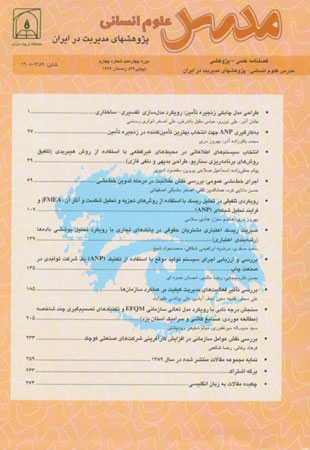Proposing a Strategic International Market Entry Model for Automotive Industry of Iran
Abstract:
With the beginning of the third millennium and the passage of about 300 years since the Industrial Revolution, the scope of operation and competition in the business enterprises has increased to a global level. Automotive industry of Iran with more than 40 years of domestic operation and allocating 2.5%of GNP, 20% value added in Industrial Sector and 2.5% of total investment in the country has not yet achieved an outstanding position in the world markets. So to prevent unfavorable (but possible) challenges in the future, it seems necessary to assess the international competition potential of this industry according to a contingent strategic model. Reviewing the current international trade theories and internationalization models of firms indicates that most of these theories and models are developed based on fundamental assumptions governing the open market in developed countries. In addition, most of these models have evolved by the post studies on the large scale multinational corporations after their internationalization process. The most important point is that each of these theories and models studied the internationalization process from a specific level of analysis (firm, industry, country, international environment). So none of these models individually and completely can be generalized to address a suitable solution for those firms operating in developing countries and struggling to enter the international markets. The main purpose of this paper is proposing a contingent international market entry model for firms operating in developing countries (like Automotive Industry of Iran) through integrating the different points of view. The model contains four levels of analysis (firm, local industry structure, national competitive policies, and firms’ international relationship with global ones). It integrates and examines the role and effects of four interdependent variables (firm characteristics, local industry structure, national policies and firms’ international relationships) shaping the strategic capabilities and competencies, which are necessary for entering the international market (as the outcome /dependent variable). The model was examined in the Iranian Automotive Industry. It indicates how the international market entry competency of a firm in developing countries is affected by it’s core competencies, synergy of local industry structure, synergy of national competitive advantage, and collaborative advantage and complimentary effect originated from international relationship between the firm and the global market.
Language:
Persian
Published:
Human Sciences MODARES, Volume:10 Issue: 1, 2006
Page:
213
magiran.com/p372955
دانلود و مطالعه متن این مقاله با یکی از روشهای زیر امکان پذیر است:
اشتراک شخصی
با عضویت و پرداخت آنلاین حق اشتراک یکساله به مبلغ 1,390,000ريال میتوانید 70 عنوان مطلب دانلود کنید!
اشتراک سازمانی
به کتابخانه دانشگاه یا محل کار خود پیشنهاد کنید تا اشتراک سازمانی این پایگاه را برای دسترسی نامحدود همه کاربران به متن مطالب تهیه نمایند!
توجه!
- حق عضویت دریافتی صرف حمایت از نشریات عضو و نگهداری، تکمیل و توسعه مگیران میشود.
- پرداخت حق اشتراک و دانلود مقالات اجازه بازنشر آن در سایر رسانههای چاپی و دیجیتال را به کاربر نمیدهد.
In order to view content subscription is required
Personal subscription
Subscribe magiran.com for 70 € euros via PayPal and download 70 articles during a year.
Organization subscription
Please contact us to subscribe your university or library for unlimited access!


